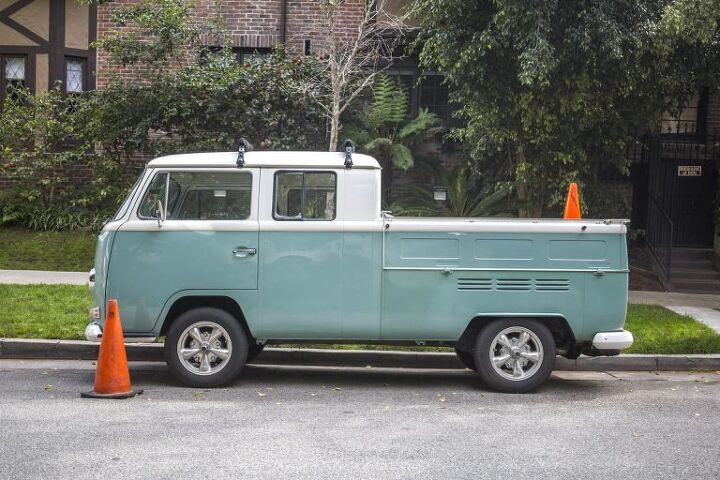Parked In Drive: 1968 Volkswagen Transporter Type II 'Doublecab'
Pickup trucks are a stereotypically American product, right up there with blue jeans and barbeque. The best-selling vehicle in America for the past 35 years? Ford F-Series. And the pickup truck defines our needs as a nation, maximizing towing, luggage, and passenger capacities as much as possible at the lowest possible price.
But must a pickup wear an American badge for us to consider it a proper truck?
After seeing innovative trucks like this 1968 VW Type II Transporter, you can’t help but ask, “Why must these be so rare in America?”
Specifically, this Type II is a “Doppelkabine” (or “Doublecab”) model, M-Code number 265, indicating a left-hand drive model with a rear door on the right side. The truck’s bare bed (Type II beds are typically wood-lined) and immaculate paintjob are possible evidence of a recent restoration, though its interior leather and finishing hint it might be one of those rare, garage kept, unicorn trucks. No wonder the owner carries assorted traffic cones and employs The Club.
Volkswagen imported only 12,070 Type II pickups to America in 1968. Less than four years later, that number officially dropped to zero. Why?
A so-called “Chicken Tax” enacted by Lyndon Baines Johnson in 1963 subjected trucks imported to the U.S. to a 25-percent tariff. (TTAC previously documented the impact of this tax and the absurd lengths companies go to thwart it.) At least one Type II fan claims the U.S government established the tariff in retaliation to a German-imposed tariff on frozen chicken from America. The U.S. chicken tax is still in effect today, and likely won’t be repealed in our present “America-first” economic climate.
Ironically, the Type II Transporter’s descendent — the VW Amarok — is used as the poster child for interesting pickup varieties we aren’t allowed to purchase in America. A late-model Amarok initially purchased in Mexico City was recently listed for $40,000 on a website for VW Van enthusiasts. The listing was removed, likely due to difficulties with importing and registration. The resulting commentary was lively, possibly hinting at pent-up American demand for a German-built truck.
If anything, the second-generation Type II (which debuted in the 1968 model year, same as today’s subject truck) was even more innovative and modular than today’s Amarok. Models could be custom-ordered from the factory with cherry-picker attachments, tilting beds, and fire truck-style ladders. The T2’s bed could collapse; the “Dropgate” gets its nickname from a transformable rear, useful for hauling items larger than a standard sheet of plywood. One wonders how differently the truck market would be divided today if the government had allowed brands like VW and Mercedes-Benz to compete equally for the last 54 years.
When I asked Richard Attwell, the founder of a popular VW Type II site, about the Chicken Tax, he replied it didn’t stop the flow of pickups completely. VW dealers could still import panel vans and pickups in small numbers for their own uses. But, in his view, the tax was “a huge deterrent” and “amounted to a subsidy,” for U.S. automakers.
Though it didn’t happen immediately, one positive impact of the tax was the surprising number of foreign automakers who built factories on U.S. soil. Forced to decide between an invariable 25% tax on every truck they import and the bundle of tax breaks, low-interest loans, and incentives that usually go with foreign investment, companies like Hyundai, Toyota, BMW, Nissan, and Mercedes-Benz decided to build, baby, build in America.
The most recent plant opened by a foreign automaker in America? That would be the Chattanooga Assembly Plant, opened by VW in Tennessee in 2011. VW initially intended the plant to produce the upscale Passat, but now it’s also producing the brand’s first large SUV, the Atlas. Surely, an American-made Amarok is a closer possibility than ever.
All photos by author, archival materials courtesy of VW Historical Archive and Dropgates.com.
Latest Car Reviews
Read moreLatest Product Reviews
Read moreRecent Comments
- SCE to AUX They're spending billions on this venture, so I hope so.Investing during a lull in the EV market seems like a smart move - "buy low, sell high" and all that.Key for Honda will be achieving high efficiency in its EVs, something not everybody can do.
- ChristianWimmer It might be overpriced for most, but probably not for the affluent city-dwellers who these are targeted at - we have tons of them in Munich where I live so I “get it”. I just think these look so terribly cheap and weird from a design POV.
- NotMyCircusNotMyMonkeys so many people here fellating musks fat sack, or hodling the baggies for TSLA. which are you?
- Kwik_Shift_Pro4X Canadians are able to win?
- Doc423 More over-priced, unreliable garbage from Mini Cooper/BMW.







































Comments
Join the conversation
Why does VW build cars in the US and Mexico? What compels them, and why would the Amarok be different with or without the chicken tax? If you say the Amarok would sell in numbersd too low to justify a Mexico build, then what would be the point anyway?
BTW : . Dual carbys DON'T EVER GO OUT OF ADJUSTMENT . . I used to tune up multi carby VW's for the SMOG tests in the 1970's , by ear, not hard until your hearing goes bad . . I always get a laugh out of people who claim carby problems when _they_ caused all the problems . . 'Carburetor' is a -French- word meaning " LEAVE IT ALONE ! " . . =8-) . . -Nate